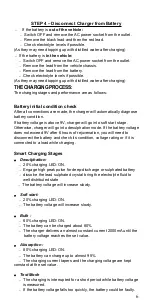
6
STEP 4 – Disconnect Charger from Battery
。
If the battery is
out of the vehicle:
。
Switch OFF and remove the AC power socket from the outlet.
。
Remove the black lead and then the red lead.
。
Check electrolyte levels if possible.
(As they may need topping up with distilled water after charging)
。
If the battery is
in the vehicle:
。
Switch OFF and remove the AC power socket from the outlet.
。
Remove the lead from the vehicle chassis.
。
Remove the lead from the battery.
。
Check electrolyte levels if possible.
(As they may need topping up with distilled water after charging)
THE CHARGING PROCESS:
The charging stages and performance are as follows:
Battery initial condition check
After all connections are made, the charger will automatically diagnose
battery condition.
If battery voltage is above 9V, charger will go into soft start stage.
Otherwise, charger will go into desulphation mode. If the battery voltage
does not exceed 9V after 6 hours of rejuvenation, you will need to
disconnect the battery and check its condition, voltage rating or if it is
connected to a load while charging.
Smart Charging Stages
。
Desulphation:
。
20% charging LED: ON.
。
Engage high peak pulse for deep-discharge or sulphated battery
。
dissolve the lead sulphated crystal bring the electrolyte fluid to
well-distributed state
。
The battery voltage will increase slowly.
。
Soft start:
。
20% charging LED: ON.
。
The battery voltage will increase slowly.
。
Bulk :
。
80% charging LED: ON.
。
The battery can be charged about 80%.
。
The charger delivers an almost constant current 2000mA until the
battery voltage reaches the set value.
。
Absorption :
。
80% charging LED: ON.
。
The battery can charge up to almost 95%.
。
The charging current tapers and the charging voltage are kept
constant at the set value.
。
Test Mode
。
The charging is interrupted for a short period while battery voltage
is measured.
。
If the battery voltage falls too quickly, the battery could be faulty.



























